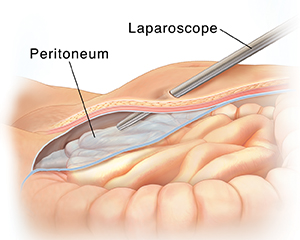Having Laparoscopic Groin Hernia Repair: TEP
A groin hernia is a bulge at a weak spot in the wall of the abdomen. Groin hernias are also called inguinal or femoral hernias. Tissue or organs may press and protrude into the weak spot. This may cause symptoms of discomfort or pain. If left untreated, a hernia can get worse and may lead to serious problems. Surgery can be done to repair a hernia.
What is laparoscopy?
Your hernia operation will be done with a method called laparoscopy. For this, a thin, lighted tube called a laparoscope is used. The scope allows the surgeon to work through a few small incisions. This is instead of the 1 larger incision that is made for open surgery. Recovery from laparoscopy is often faster and less painful than from open surgery.
What is TEP?
TEP is one way to do a hernia repair. It stands for totally extraperitoneal. The peritoneum is a membrane that covers the organs in the abdomen. During TEP, the peritoneum is not opened. Instead, the hernia is repaired from outside the peritoneum. Your surgeon may do this procedure using a surgical robot. This is when the surgeon guides a special robot instead of guiding the surgical instruments by hand. This is commonly called robotic surgery. Robotic surgery also uses several small incisions, and the recovery is generally the same as laparoscopy.

Preparing for your surgery
-
Schedule tests as you have been told. These make sure your heart and lungs are healthy for surgery.
-
Tell your health care provider about all medicines you take including aspirin, nonsteroidal anti-inflammatory drugs, such as ibuprofen, or other blood-thinning medicines, such as warfarin. Also tell your provider about any herbs and other supplements you take. You may need to stop taking some or all of them before surgery.
-
Ask your provider for help in quitting smoking. This will help stop the hernia from being strained by smoker’s cough. It will also promote good blood flow for healing. Smoking can also make you more likely to have breathing issues during anesthesia.
-
Don't lift anything heavy. It can strain your hernia and make it worse.
-
Wash with a special scrub before surgery, if you are told to do so.
-
Follow any directions you are given for taking medicines and for not eating or drinking before surgery.
-
Plan to have an adult family member or friend drive you home from the surgery. Arrange for help with chores and errands while you recover.
During the procedure
The surgery typically takes 1 to 2 hours. You can likely go home the same day. Before the surgery starts, an I.V. (intravenous) line is put into a vein in your arm or hand. This line supplies fluids and medicine.
-
To keep you free of pain during the surgery, you’ll be given anesthesia. This may be general anesthesia. This type of anesthesia puts you in a deep sleep through the procedure. Or you may be given regional anesthesia. This numbs the abdomen and makes you relaxed and drowsy through the surgery.
-
The surgeon makes 3 to 4 small incisions in the abdomen. The scope is put through 1 of the incisions. The scope sends live pictures to a video screen. This lets the surgeon see inside the abdomen. Surgical tools are placed through the other small incisions.
-
Your abdomen is inflated with carbon dioxide. This gas provides space for the surgeon to see and work to repair the hernia.
-
Using the surgical tools, the surgeon exposes and repairs the hernia.
-
After the repair, a patch of strong mesh is usually put over the weak spot in your abdominal wall. The patch acts like a patch on a tire. Most mesh stays in place permanently.
-
The gas is released from your abdomen. This causes the space that was created to close, covering the mesh. Your incisions are then closed with sutures (stitches).
Risks and possible complications of groin hernia repair
-
Bleeding.
-
Infection.
-
Numbness or pain in the groin or leg.
-
Urinary retention (inability to urinate).
-
Bowel or bladder injury.
-
Hernia comes back or new hernia forms.
-
Injury to the testes.
-
Problems from mesh.
-
Risks of anesthesia.
Online Medical Reviewer:
Heather M Trevino BSN RNC
Online Medical Reviewer:
Jen Lehrer MD
Online Medical Reviewer:
Melinda Murray Ratini DO
Date Last Reviewed:
2/1/2025
© 2000-2025 The StayWell Company, LLC. All rights reserved. This information is not intended as a substitute for professional medical care. Always follow your healthcare professional's instructions.